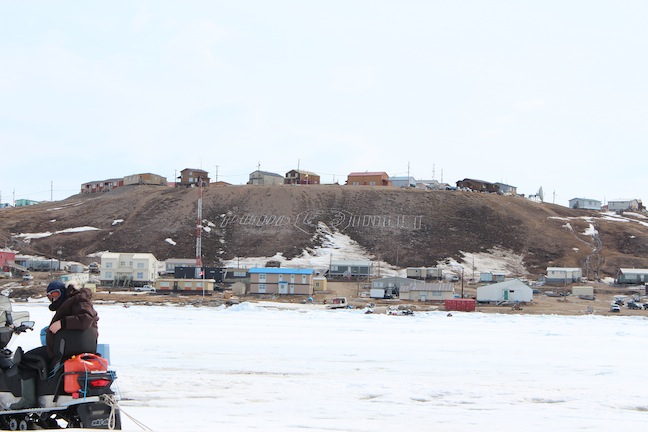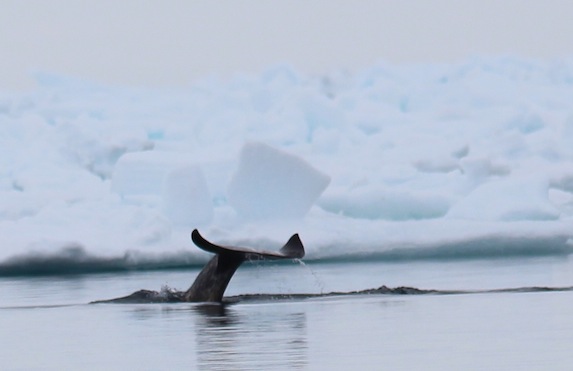
Where We Are Tonight
Pond Inlet, Nunavut
(Photo courtesy of Ryan and Elaine)

| Elaine was able to make a video of a mature male Narwhal swimming along in front of our edge. If you watch carefully at the end, you will see him raise his tusk out of the water just before his final dive reveals his fluke. |
| By the time she made that video, we were all aware that the pack ice was moving in and that it seemed to be accelerating. I had zoomed in on it around 8 and could see that the chunks in the pack were massive. By 9, it was clear from the ice blink that the pack was really extensive. |
|
Massive pack ice |
The ice blink above it |
| As the pack ice moved closer, the Narwhals were forced closer to our floe edge, which made a feast for us all. |
 Narwhal and pack ice (Photo courtesy of Ryan and Elaine) |
| The crash came just before 10. I made a video of the last few moments, but didn’t get the actual crash because (not unreasonably) Tom moved us all back fifty feet from the edge just before the impact. |
| In fact, the crash was pretty much a non-event in that it made no noise and we didn’t feel any impact, but the edge of the floe did crumple and we were suddenly faced with a massive wall of ice that went on further than we could see, in place of the open sea we have been enjoying since we arrived. |
|
|
|
|
As we were all still standing there in awe looking at how much our world had
just changed, somebody spotted a Polar Bear out on the pack ice a kilometer
or so to our left. It seemed to be heading to our floe, but then (somewhat
worryingly) we lost track of it when another bear was spotted a kilometer or so
to our right. We tracked that one as it clambered through the pack ice and onto
the floe, passing between our camp and the CBC camp. With our binoculars, we
could see that the folks at the other camp were aware of it. As it drew closer
to them, they fired warning shots, which caused it to head away toward the
mountains.
I found myself astonished that I had actually myself photographed a Polar Bear! Ryan, of course, had gotten a photo of it looking cute and fluffy rolling over to take a snow bath. |
|
My best Polar Bear photo |
 (Photo courtesy of Ryan and Elaine) |
| And, better yet, Elaine had managed to get a (really must-watch) video of it as it traveled through the pack ice and explored our ice floe. |
| At the same time that I was taking my last photo of the Polar Bear as it strolled toward the mountains, Jenny was taking one of our Polar Bear guard dog (who is undoubtedly worn out from nursing those three puppies). |
|
|
 (Photo courtesy of Jenny Varley) |
|
By then it was time for us all to scurry to our tents and finish packing to be
ready for our 11am departure time. How could anyone have scripted a more
spectacular finale to our time on the ice?
After we’d gotten the qamutiqs loaded, we got together for a group photo: |
|
(Photo courtesy of Tom Lennartz) |
| And then we set out on our 90-kilometer journey back along the ice to Pond Inlet. |
|
| If you would like to share some of the qamutiq experience with us, try these three videos that Elaine made (she doesn’t apologize for the unsteady image — that is definitely part of the experience): |
| What it’s like to ride a qamutiq: | |
| Going over a lead in the ice: | |
| Freeing a snowmobile stuck in the slush: |
| The day was brighter than when we’d made the journey before, so the scenery was even more stunning. There was more meltwater atop the ice, which made for dramatic reflections. We couldn’t stop taking photos. I will indulge myself by showing you four of mine: |
|
|
|
|
|
|
|
Those reflections were so perfect that sometimes when I looked out into them
from the whizzing qamutiq, my brain told me that we were in danger of tumbling
down into the sky below us.
I rode with Emma again and shared her dismay when she spotted a male King Eider floating in a pool atop the ice along the way and couldn’t ask anyone to stop to let us look at it closely (it was the first one we’d seen not flying). At that moment, we were zigzagging back and forth across the inlet to get through a series of cracks in the ice, so I had difficulty even keeping my eyes on the eider, let alone trying to view it with binocular or camera. I was also disappointed that we didn’t stop at the rumored Gyrfalcon’s nest, which seems to have been overlooked in all the effort of moving us back to Pond Inlet. (But that’s my only disappointment of the entire week.) |
|
We are so used to being alone that it was almost shocking when we encountered
another group of snowmobiles and qamutiqs coming out from Pond Inlet as we were
going toward it. Emma muttered, “Tourists!”
We were back on land about 5:30, being greeted by the families of the guides. We carefully avoided stepping in the seal blubber as we piled our duffles onto a single qamutiq that a bunch of men hauled from the ice up to the road so that the bags could be loaded into a truck. And then we began the long trudge up to the hotel ourselves. Wearing so many layers of clothing, we found this to be no fun at all. (I quickly realized that I should have taken Tom up on his offer of a ride in the baggage truck.) I was deeply grateful that Emma and Jo stayed back with me and even carried some of my gear and the heavy clothing I was shedding. I would have been in trouble on my own (for one thing, given my entire lack of a sense of direction, I would likely not have found the hotel by myself). I was really done in by the time we got up to the hotel. I drank three glasses of water even before emailing Lee that we were back. |
